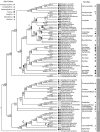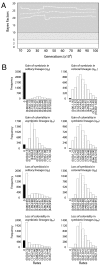Repeated loss of coloniality and symbiosis in scleractinian corals
- PMID: 20547851
- PMCID: PMC2900674
- DOI: 10.1073/pnas.0914380107
Repeated loss of coloniality and symbiosis in scleractinian corals
Abstract
The combination of coloniality and symbiosis in Scleractinia is thought to confer competitive advantage over other benthic invertebrates, and it is likely the key factor for the dominance of corals in tropical reefs. However, the extant Scleractinia are evenly split between zooxanthellate and azooxanthellate species. Most azooxanthellate species are solitary and nearly absent from reefs, but have much wider geographic and bathymetric distributions than reef corals. Molecular phylogenetic analyses have repeatedly recovered clades formed by colonial/zooxanthellate and solitary/azooxanthellate taxa, suggesting that coloniality and symbiosis were repeatedly acquired and/or lost throughout the history of the Scleractinia. Using Bayesian ancestral state reconstruction, we found that symbiosis was lost at least three times and coloniality lost at least six times, and at least two instances in which both characters were lost. All of the azooxanthellate lineages originated from ancestors that were reconstructed as symbiotic, corroborating the onshore-offshore diversification trend recorded in marine taxa. Symbiotic sister taxa of two of these descendant lineages are extant in Caribbean reefs but disappeared from the Mediterranean before the end of the Miocene, whereas extant azooxanthellate lineages have trans-Atlantic distributions. Thus, the phyletic link between reef and nonreef communities may have played an important role in the dynamics of extinction and recovery that marks the evolutionary history of scleractinians, and some reef lineages may have escaped local extinction by diversifying into offshore environments. However, this macroevolutionary mechanism offers no hope of mitigating the effects of climate change on coral reefs in the next century.
Conflict of interest statement
The authors declare no conflict of interest.
Figures


References
-
- Beklemishev WN. Colonies of bilateria and general principles of development of the colonial habit in multicellular animals. In: Kabata Z, editor. Principles of Comparative Anatomy of Invertebrates—Promorphology. 3rd Ed. Vol 1. Edinburgh: Oliver and Boyd; 1969. pp. 430–478.
-
- Rosen BR. Modular growth and form of corals: A matter of metamers? Philos Trans R Soc Lond B Biol Sci. 1986;313:115–142.
-
- Coates AG, Oliver WA., Jr . Coloniality in Zoantharian corals. In: Boardman RS, Cheetam A, Oliver WA Jr., editors. Animal Colonies—Development and Function through time. Stroudsburg: Dowden, Hutchinson & Ross; 1973. pp. 3–27.
-
- Coates AG, Jackson JBC. Clonal growth, algal symbiosis, and reef formation by corals. Paleobiology. 1987;13:363–378.
-
- Cairns SD. A Revision of the Ahermatypic Scleractinia of the Galapagos and Cocos Islands. Washington, DC: Smithsonian Institution Press; 1991. p. 44.
Publication types
MeSH terms
Substances
Associated data
- Actions
- Actions
- Actions
- Actions
- Actions
- Actions
- Actions
- Actions
- Actions
- Actions
- Actions
- Actions
- Actions
- Actions
- Actions
- Actions
- Actions
- Actions
- Actions
- Actions
- Actions
- Actions
- Actions
- Actions
- Actions
- Actions
- Actions
- Actions
- Actions
- Actions
- Actions
- Actions
- Actions
- Actions
- Actions
- Actions
- Actions
- Actions
- Actions
- Actions
- Actions
- Actions
- Actions
- Actions
- Actions
- Actions
- Actions
- Actions
- Actions
- Actions
- Actions
- Actions
- Actions
- Actions
- Actions
- Actions
- Actions
- Actions
- Actions
- Actions
- Actions
- Actions
- Actions
- Actions
- Actions
- Actions
- Actions
- Actions
- Actions
- Actions
- Actions
- Actions
- Actions
- Actions
- Actions
- Actions
- Actions
- Actions
- Actions
- Actions
- Actions
- Actions
- Actions
- Actions
- Actions
- Actions
- Actions
- Actions
- Actions
- Actions
- Actions
- Actions
- Actions
- Actions
- Actions
- Actions
- Actions
- Actions
- Actions
- Actions
- Actions
- Actions
- Actions
- Actions
- Actions
- Actions
- Actions
- Actions
- Actions
- Actions
- Actions
- Actions
- Actions
- Actions
- Actions
- Actions
- Actions
- Actions
- Actions
- Actions
- Actions
- Actions
- Actions
- Actions
- Actions
- Actions
- Actions
- Actions
- Actions
- Actions
- Actions
- Actions
- Actions
- Actions
- Actions
- Actions
- Actions
- Actions
- Actions
- Actions
- Actions
- Actions
- Actions
- Actions
- Actions
- Actions
- Actions
- Actions
- Actions
- Actions
- Actions
- Actions
- Actions
- Actions
- Actions
- Actions
- Actions
- Actions
- Actions
- Actions
- Actions
- Actions
- Actions
- Actions
- Actions
- Actions
- Actions
- Actions
- Actions
- Actions
- Actions
- Actions
LinkOut - more resources
Full Text Sources
Other Literature Sources
Molecular Biology Databases

